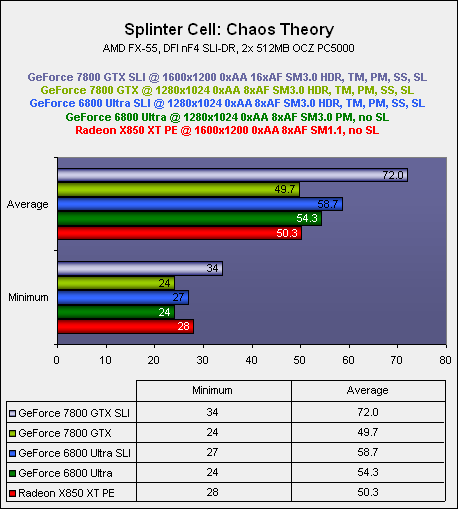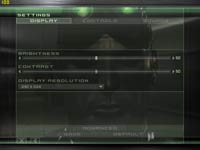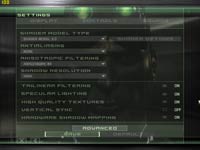
Splinter Cell: Chaos Theory
Publisher: UbisoftWe are using the full version of Splinter Cell: Chaos Theory patched to version 1.02. It features a new game engine that has been created around a heavily modified Unreal Engine 2 - the important thing to note is that the game only has two Shader profiles: Shader Model 1.1 and Shader Model 3.0. This means that all of ATI's video cards default to Shader Model 1.1, and only the GeForce 6 series are capable of using the Shader Model 3.0 path.
Despite the fact that ATI's cards only use a DirectX 8.1, Shader Model 1.1 path, the quality of rendering is fantastic in comparison to the Shader Model 3.0 rendering. However, the Shader Model 3.0 profile means that the GeForce 6 series and higher video cards are given a number of options for additional eye candy, including Parallax Mapping, High Dynamic Range Rendering, Tone Mapping and High-Quality Soft Shadows. These can all be enabled on GeForce 6 and GeForce 7 series video cards, and will make the gaming experience more realistic providing there is enough graphics processing power available.
We configured both Anti-Aliasing and Anisotropic Filtering from within the game, and thus the driver control panel was left set to "Application Controlled".
When we used a pair of GeForce 7800 GTX's together in SLI mode, we found that we could play this game with absolutely everything turned on, at the highest available resolution. That means we could play at 1600x1200 0xAA 16xAF with HDR, Tone Mapping, Parallax Mapping, High-Quality Soft Shadows and Specular Lighting all enabled. We have not been able to experience the game like this before, and we have to say that it looks absolutely fantastic in all of its glory.
With a single GeForce 7800 GTX, we were able to attain a smooth gaming experience at 1280x1024 0xAA 8xAF with HDR, Tone Mapping, Parallax Mapping, High-Quality Soft Shadows and Specular Lighting all enabled. A pair of GeForce 6800 Ultra's were able to deliver a solid frame rate at the same detail settings, but the frame rate was slightly higher than a single GeForce 7800 GTX.
A single GeForce 6800 Ultra delivered acceptable gaming performance at 1280x1024 0xAA 8xAF with Parallax Mapping enabled and Specular Lighting disabled. Specular Lighting does help to greatly improve the game experience, but we found that the performance hit after enabling it was not worth it, and we would have to drop the resolution down to 1024x768 with it turned on in order to attain hitch-free game play.
Finally, our Radeon X850 XT Platinum Edition does not support Shader Model 3.0, and thus is forced to run the Shader Model 1.1 path. When we first ran this, we were incredibly surprised at the great job that Ubisoft have done with optimising a DirectX 8.1 code path to deliver so much image quality. On its own, the image quality is great, but then when you put it along side the same scene rendered by the Shader Model 3.0 path, you can see the inherent differences in image quality – there are some phenomenal differences between Shader Model 3.0 and Shader Model 1.1. We found that the Radeon X850 XT Platinum Edition was completely playable at 1600x1200 0xAA 8xAF with Specular Lighting disabled.
There is a problem with Specular Lighting running in DirectX 8.1, in that textures appear very blocky due to the way that the light maps are implemented in to Shader Model 1.1. This problem existed on both ATI and NVIDIA hardware when running the Shader Model 1.1 path, so we believe that it is an API-related issue, rather than an issue with either vendor's ability to render specular light maps.

The Radeon X850 XT Platinum Edition does not contest on the image quality front in this title, but if you were not looking at a GeForce 6 or GeForce 7 series sitting side by side with a Radeon X850 XT PE, you would not be massively disappointed by the image quality delivered by the latter.

MSI MPG Velox 100R Chassis Review
October 14 2021 | 15:04







Want to comment? Please log in.